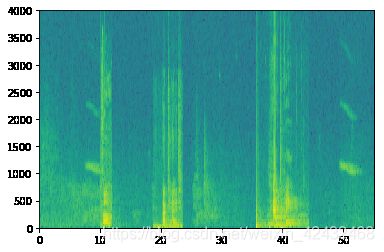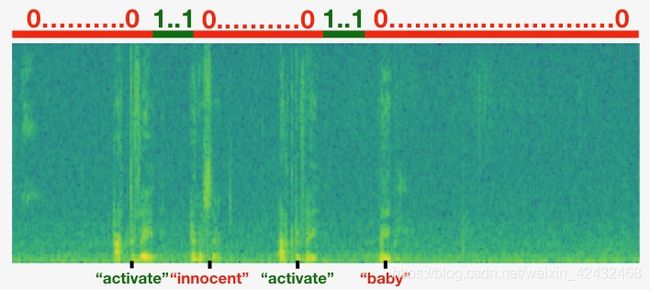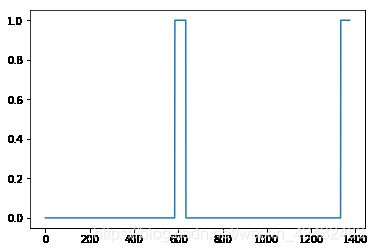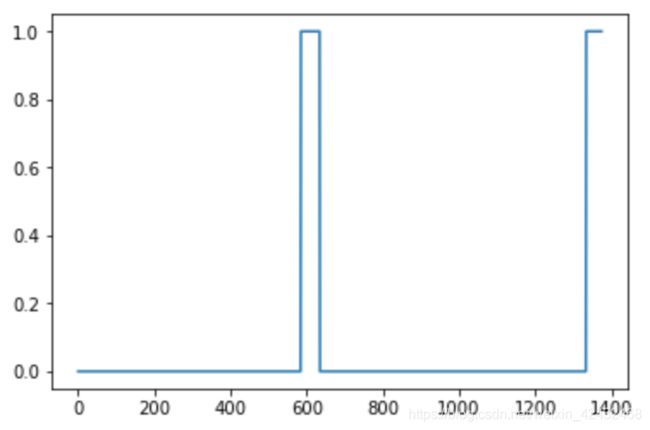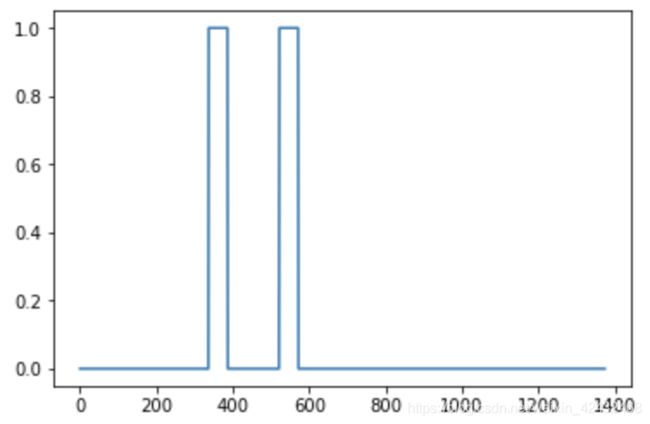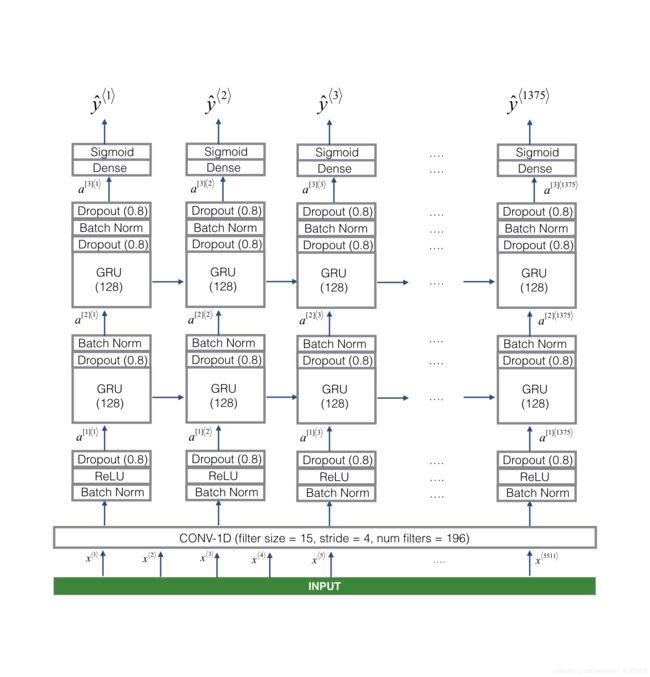吴恩达深度学习5.3练习_Sequence Models_Trigger word detection
转载自吴恩达老师深度学习课程作业notebook
Trigger Word Detection
Welcome to the final programming assignment of this specialization!
In this week’s videos, you learned about applying deep learning to speech recognition. In this assignment, you will construct a speech dataset and implement an algorithm for trigger word detection (sometimes also called keyword detection, or wakeword detection). Trigger word detection is the technology that allows devices like Amazon Alexa, Google Home, Apple Siri, and Baidu DuerOS to wake up upon hearing a certain word.
For this exercise, our trigger word will be “Activate.” Every time it hears you say “activate,” it will make a “chiming” sound. By the end of this assignment, you will be able to record a clip of yourself talking, and have the algorithm trigger a chime when it detects you saying “activate.”
After completing this assignment, perhaps you can also extend it to run on your laptop so that every time you say “activate” it starts up your favorite app, or turns on a network connected lamp in your house, or triggers some other event?
In this assignment you will learn to:
- Structure a speech recognition project
- Synthesize and process audio recordings to create train/dev datasets
- Train a trigger word detection model and make predictions
Lets get started! Run the following cell to load the package you are going to use.
import numpy as np
from pydub import AudioSegment
import random
import sys
import io
import os
import glob
import IPython
from td_utils import *
%matplotlib inline
1 - Data synthesis: Creating a speech dataset
Let’s start by building a dataset for your trigger word detection algorithm. A speech dataset should ideally be as close as possible to the application you will want to run it on. In this case, you’d like to detect the word “activate” in working environments (library, home, offices, open-spaces …). You thus need to create recordings with a mix of positive words (“activate”) and negative words (random words other than activate) on different background sounds. Let’s see how you can create such a dataset.
1.1 - Listening to the data
One of your friends is helping you out on this project, and they’ve gone to libraries, cafes, restaurants, homes and offices all around the region to record background noises, as well as snippets of audio of people saying positive/negative words. This dataset includes people speaking in a variety of accents.
In the raw_data directory, you can find a subset of the raw audio files of the positive words, negative words, and background noise. You will use these audio files to synthesize a dataset to train the model. The “activate” directory contains positive examples of people saying the word “activate”. The “negatives” directory contains negative examples of people saying random words other than “activate”. There is one word per audio recording. The “backgrounds” directory contains 10 second clips of background noise in different environments.
Run the cells below to listen to some examples.
IPython.display.Audio("./raw_data/activates/1.wav")
IPython.display.Audio("./raw_data/negatives/4.wav")
IPython.display.Audio("./raw_data/backgrounds/1.wav")
You will use these three type of recordings (positives/negatives/backgrounds) to create a labelled dataset.
1.2 - From audio recordings to spectrograms
What really is an audio recording? A microphone records little variations in air pressure over time, and it is these little variations in air pressure that your ear also perceives as sound. You can think of an audio recording is a long list of numbers measuring the little air pressure changes detected by the microphone. We will use audio sampled at 44100 Hz (or 44100 Hertz). This means the microphone gives us 44100 numbers per second. Thus, a 10 second audio clip is represented by 441000 numbers (= 10 × 44100 10 \times 44100 10×44100).
It is quite difficult to figure out from this “raw” representation of audio whether the word “activate” was said. In order to help your sequence model more easily learn to detect triggerwords, we will compute a spectrogram of the audio. The spectrogram tells us how much different frequencies are present in an audio clip at a moment in time.
(If you’ve ever taken an advanced class on signal processing or on Fourier transforms, a spectrogram is computed by sliding a window over the raw audio signal, and calculates the most active frequencies in each window using a Fourier transform. If you don’t understand the previous sentence, don’t worry about it.)
Lets see an example.
IPython.display.Audio("audio_examples/example_train.wav")
x = graph_spectrogram("audio_examples/example_train.wav")
The graph above represents how active each frequency is (y axis) over a number of time-steps (x axis).
The dimension of the output spectrogram depends upon the hyperparameters of the spectrogram software and the length of the input. In this notebook, we will be working with 10 second audio clips as the “standard length” for our training examples. The number of timesteps of the spectrogram will be 5511. You’ll see later that the spectrogram will be the input x x x into the network, and so T x = 5511 T_x = 5511 Tx=5511.
_, data = wavfile.read("audio_examples/example_train.wav")
print("Time steps in audio recording before spectrogram", data[:,0].shape)
print("Time steps in input after spectrogram", x.shape)
Time steps in audio recording before spectrogram (441000,)
Time steps in input after spectrogram (101, 5511)
Now, you can define:
Tx = 5511 # The number of time steps input to the model from the spectrogram
n_freq = 101 # Number of frequencies input to the model at each time step of the spectrogram
Note that even with 10 seconds being our default training example length, 10 seconds of time can be discretized to different numbers of value. You’ve seen 441000 (raw audio) and 5511 (spectrogram). In the former case, each step represents 10 / 441000 ≈ 0.000023 10/441000 \approx 0.000023 10/441000≈0.000023 seconds. In the second case, each step represents 10 / 5511 ≈ 0.0018 10/5511 \approx 0.0018 10/5511≈0.0018 seconds.
For the 10sec of audio, the key values you will see in this assignment are:
- 441000 441000 441000 (raw audio)
- 5511 = T x 5511 = T_x 5511=Tx (spectrogram output, and dimension of input to the neural network).
- 10000 10000 10000 (used by the
pydubmodule to synthesize audio) - 1375 = T y 1375 = T_y 1375=Ty (the number of steps in the output of the GRU you’ll build).
Note that each of these representations correspond to exactly 10 seconds of time. It’s just that they are discretizing them to different degrees. All of these are hyperparameters and can be changed (except the 441000, which is a function of the microphone). We have chosen values that are within the standard ranges uses for speech systems.
Consider the T y = 1375 T_y = 1375 Ty=1375 number above. This means that for the output of the model, we discretize the 10s into 1375 time-intervals (each one of length 10 / 1375 ≈ 0.0072 10/1375 \approx 0.0072 10/1375≈0.0072s) and try to predict for each of these intervals whether someone recently finished saying “activate.”
Consider also the 10000 number above. This corresponds to discretizing the 10sec clip into 10/10000 = 0.001 second itervals. 0.001 seconds is also called 1 millisecond, or 1ms. So when we say we are discretizing according to 1ms intervals, it means we are using 10,000 steps.
Ty = 1375 # The number of time steps in the output of our model
1.3 - Generating a single training example
Because speech data is hard to acquire and label, you will synthesize your training data using the audio clips of activates, negatives, and backgrounds. It is quite slow to record lots of 10 second audio clips with random “activates” in it. Instead, it is easier to record lots of positives and negative words, and record background noise separately (or download background noise from free online sources).
To synthesize a single training example, you will:
- Pick a random 10 second background audio clip
- Randomly insert 0-4 audio clips of “activate” into this 10sec clip
- Randomly insert 0-2 audio clips of negative words into this 10sec clip
Because you had synthesized the word “activate” into the background clip, you know exactly when in the 10sec clip the “activate” makes its appearance. You’ll see later that this makes it easier to generate the labels y ⟨ t ⟩ y^{\langle t \rangle} y⟨t⟩ as well.
You will use the pydub package to manipulate audio. Pydub converts raw audio files into lists of Pydub data structures (it is not important to know the details here). Pydub uses 1ms as the discretization interval (1ms is 1 millisecond = 1/1000 seconds) which is why a 10sec clip is always represented using 10,000 steps.
# Load audio segments using pydub
activates, negatives, backgrounds = load_raw_audio()
print("background len: " + str(len(backgrounds[0]))) # Should be 10,000, since it is a 10 sec clip
print("activate[0] len: " + str(len(activates[0]))) # Maybe around 1000, since an "activate" audio clip is usually around 1 sec (but varies a lot)
print("activate[1] len: " + str(len(activates[1]))) # Different "activate" clips can have different lengths
background len: 10000
activate[0] len: 721
activate[1] len: 731
Overlaying positive/negative words on the background:
Given a 10sec background clip and a short audio clip (positive or negative word), you need to be able to “add” or “insert” the word’s short audio clip onto the background. To ensure audio segments inserted onto the background do not overlap, you will keep track of the times of previously inserted audio clips. You will be inserting multiple clips of positive/negative words onto the background, and you don’t want to insert an “activate” or a random word somewhere that overlaps with another clip you had previously added.
For clarity, when you insert a 1sec “activate” onto a 10sec clip of cafe noise, you end up with a 10sec clip that sounds like someone sayng “activate” in a cafe, with “activate” superimposed on the background cafe noise. You do not end up with an 11 sec clip. You’ll see later how pydub allows you to do this.
Creating the labels at the same time you overlay:
Recall also that the labels y ⟨ t ⟩ y^{\langle t \rangle} y⟨t⟩ represent whether or not someone has just finished saying “activate.” Given a background clip, we can initialize y ⟨ t ⟩ = 0 y^{\langle t \rangle}=0 y⟨t⟩=0 for all t t t, since the clip doesn’t contain any “activates.”
When you insert or overlay an “activate” clip, you will also update labels for y ⟨ t ⟩ y^{\langle t \rangle} y⟨t⟩, so that 50 steps of the output now have target label 1. You will train a GRU to detect when someone has finished saying “activate”. For example, suppose the synthesized “activate” clip ends at the 5sec mark in the 10sec audio—exactly halfway into the clip. Recall that T y = 1375 T_y = 1375 Ty=1375, so timestep $687 = $ int(1375*0.5) corresponds to the moment at 5sec into the audio. So, you will set y ⟨ 688 ⟩ = 1 y^{\langle 688 \rangle} = 1 y⟨688⟩=1. Further, you would quite satisfied if the GRU detects “activate” anywhere within a short time-internal after this moment, so we actually set 50 consecutive values of the label y ⟨ t ⟩ y^{\langle t \rangle} y⟨t⟩ to 1. Specifically, we have y ⟨ 688 ⟩ = y ⟨ 689 ⟩ = ⋯ = y ⟨ 737 ⟩ = 1 y^{\langle 688 \rangle} = y^{\langle 689 \rangle} = \cdots = y^{\langle 737 \rangle} = 1 y⟨688⟩=y⟨689⟩=⋯=y⟨737⟩=1.
This is another reason for synthesizing the training data: It’s relatively straightforward to generate these labels y ⟨ t ⟩ y^{\langle t \rangle} y⟨t⟩ as described above. In contrast, if you have 10sec of audio recorded on a microphone, it’s quite time consuming for a person to listen to it and mark manually exactly when “activate” finished.
Here’s a figure illustrating the labels y ⟨ t ⟩ y^{\langle t \rangle} y⟨t⟩, for a clip which we have inserted “activate”, “innocent”, activate", “baby.” Note that the positive labels “1” are associated only with the positive words.
To implement the training set synthesis process, you will use the following helper functions. All of these function will use a 1ms discretization interval, so the 10sec of audio is alwsys discretized into 10,000 steps.
get_random_time_segment(segment_ms)gets a random time segment in our background audiois_overlapping(segment_time, existing_segments)checks if a time segment overlaps with existing segmentsinsert_audio_clip(background, audio_clip, existing_times)inserts an audio segment at a random time in our background audio usingget_random_time_segmentandis_overlappinginsert_ones(y, segment_end_ms)inserts 1’s into our label vector y after the word “activate”
The function get_random_time_segment(segment_ms) returns a random time segment onto which we can insert an audio clip of duration segment_ms. Read through the code to make sure you understand what it is doing.
def get_random_time_segment(segment_ms):
"""
Gets a random time segment of duration segment_ms in a 10,000 ms audio clip.
Arguments:
segment_ms -- the duration of the audio clip in ms ("ms" stands for "milliseconds")
Returns:
segment_time -- a tuple of (segment_start, segment_end) in ms
"""
segment_start = np.random.randint(low=0, high=10000-segment_ms) # Make sure segment doesn't run past the 10sec background
segment_end = segment_start + segment_ms - 1
return (segment_start, segment_end)
Next, suppose you have inserted audio clips at segments (1000,1800) and (3400,4500). I.e., the first segment starts at step 1000, and ends at step 1800. Now, if we are considering inserting a new audio clip at (3000,3600) does this overlap with one of the previously inserted segments? In this case, (3000,3600) and (3400,4500) overlap, so we should decide against inserting a clip here.
For the purpose of this function, define (100,200) and (200,250) to be overlapping, since they overlap at timestep 200. However, (100,199) and (200,250) are non-overlapping.
Exercise: Implement is_overlapping(segment_time, existing_segments) to check if a new time segment overlaps with any of the previous segments. You will need to carry out 2 steps:
- Create a “False” flag, that you will later set to “True” if you find that there is an overlap.
- Loop over the previous_segments’ start and end times. Compare these times to the segment’s start and end times. If there is an overlap, set the flag defined in (1) as True. You can use:
for ....:
if ... <= ... and ... >= ...:
...
Hint: There is overlap if the segment starts before the previous segment ends, and the segment ends after the previous segment starts.
# GRADED FUNCTION: is_overlapping
def is_overlapping(segment_time, previous_segments):
"""
Checks if the time of a segment overlaps with the times of existing segments.
Arguments:
segment_time -- a tuple of (segment_start, segment_end) for the new segment
previous_segments -- a list of tuples of (segment_start, segment_end) for the existing segments
Returns:
True if the time segment overlaps with any of the existing segments, False otherwise
"""
segment_start, segment_end = segment_time
### START CODE HERE ### (≈ 4 line)
# Step 1: Initialize overlap as a "False" flag. (≈ 1 line)
overlap = False
# Step 2: loop over the previous_segments start and end times.
# Compare start/end times and set the flag to True if there is an overlap (≈ 3 lines)
for previous_start, previous_end in previous_segments:
if segment_start <= previous_end and segment_end >= previous_start:
overlap = True
### END CODE HERE ###
return overlap
overlap1 = is_overlapping((950, 1430), [(2000, 2550), (260, 949)])
overlap2 = is_overlapping((2305, 2950), [(824, 1532), (1900, 2305), (3424, 3656)])
print("Overlap 1 = ", overlap1)
print("Overlap 2 = ", overlap2)
Overlap 1 = False
Overlap 2 = True
Expected Output:
Overlap 1
FalseOverlap 2
TrueNow, lets use the previous helper functions to insert a new audio clip onto the 10sec background at a random time, but making sure that any newly inserted segment doesn’t overlap with the previous segments.
Exercise: Implement insert_audio_clip() to overlay an audio clip onto the background 10sec clip. You will need to carry out 4 steps:
- Get a random time segment of the right duration in ms.
- Make sure that the time segment does not overlap with any of the previous time segments. If it is overlapping, then go back to step 1 and pick a new time segment.
- Add the new time segment to the list of existing time segments, so as to keep track of all the segments you’ve inserted.
- Overlay the audio clip over the background using pydub. We have implemented this for you.
# GRADED FUNCTION: insert_audio_clip
def insert_audio_clip(background, audio_clip, previous_segments):
"""
Insert a new audio segment over the background noise at a random time step, ensuring that the
audio segment does not overlap with existing segments.
Arguments:
background -- a 10 second background audio recording.
audio_clip -- the audio clip to be inserted/overlaid.
previous_segments -- times where audio segments have already been placed
Returns:
new_background -- the updated background audio
"""
# Get the duration of the audio clip in ms
segment_ms = len(audio_clip)
### START CODE HERE ###
# Step 1: Use one of the helper functions to pick a random time segment onto which to insert
# the new audio clip. (≈ 1 line)
segment_time = get_random_time_segment(segment_ms)
# Step 2: Check if the new segment_time overlaps with one of the previous_segments. If so, keep
# picking new segment_time at random until it doesn't overlap. (≈ 2 lines)
while is_overlapping(segment_time, previous_segments):
segment_time = get_random_time_segment(segment_ms)
# Step 3: Add the new segment_time to the list of previous_segments (≈ 1 line)
previous_segments.append(segment_time)
### END CODE HERE ###
# Step 4: Superpose audio segment and background
new_background = background.overlay(audio_clip, position = segment_time[0])
return new_background, segment_time
np.random.seed(5)
audio_clip, segment_time = insert_audio_clip(backgrounds[0], activates[3], [(3790, 4400)])
audio_clip.export("insert_test.wav", format="wav")
print("Segment Time: ", segment_time)
IPython.display.Audio("insert_test.wav")
Expected Output
Segment Time
(2254, 3169)# Expected audio
IPython.display.Audio("audio_examples/insert_reference.wav")
Finally, implement code to update the labels y ⟨ t ⟩ y^{\langle t \rangle} y⟨t⟩, assuming you just inserted an “activate.” In the code below, y is a (1,1375) dimensional vector, since T y = 1375 T_y = 1375 Ty=1375.
If the “activate” ended at time step t t t, then set y ⟨ t + 1 ⟩ = 1 y^{\langle t+1 \rangle} = 1 y⟨t+1⟩=1 as well as for up to 49 additional consecutive values. However, make sure you don’t run off the end of the array and try to update y[0][1375], since the valid indices are y[0][0] through y[0][1374] because T y = 1375 T_y = 1375 Ty=1375. So if “activate” ends at step 1370, you would get only y[0][1371] = y[0][1372] = y[0][1373] = y[0][1374] = 1
Exercise: Implement insert_ones(). You can use a for loop. (If you are an expert in python’s slice operations, feel free also to use slicing to vectorize this.) If a segment ends at segment_end_ms (using a 10000 step discretization), to convert it to the indexing for the outputs y y y (using a 1375 1375 1375 step discretization), we will use this formula:
segment_end_y = int(segment_end_ms * Ty / 10000.0)
# GRADED FUNCTION: insert_ones
def insert_ones(y, segment_end_ms):
"""
Update the label vector y. The labels of the 50 output steps strictly after the end of the segment
should be set to 1. By strictly we mean that the label of segment_end_y should be 0 while, the
50 followinf labels should be ones.
Arguments:
y -- numpy array of shape (1, Ty), the labels of the training example
segment_end_ms -- the end time of the segment in ms
Returns:
y -- updated labels
"""
# duration of the background (in terms of spectrogram time-steps)
segment_end_y = int(segment_end_ms * Ty / 10000.0)
'''
为什么要检测到activate之后设置标签为1,而不是在插入activate的segment_start_ms时候输入1,
每段activate长度不一样,也就是实际上说完activate到你的y标签设为1的距离每次是不一样的
如果在插入activate时就把y标签设置为1,也存在这个问题,因为设置y标签为1的位置与真正开始说activate的位置距离也是有波动的
'''
# Add 1 to the correct index in the background label (y)
### START CODE HERE ### (≈ 3 lines)
for i in range(segment_end_y + 1, segment_end_y + 51):
if i < Ty:
y[0, i] = 1
### END CODE HERE ###
return y
arr1 = insert_ones(np.zeros((1, Ty)), 9700)
plt.plot(insert_ones(arr1, 4251)[0,:])
print("sanity checks:", arr1[0][1333], arr1[0][634], arr1[0][635])
sanity checks: 0.0 1.0 0.0
Expected Output
sanity checks:
0.0 1.0 0.0Finally, you can use insert_audio_clip and insert_ones to create a new training example.
Exercise: Implement create_training_example(). You will need to carry out the following steps:
- Initialize the label vector y y y as a numpy array of zeros and shape ( 1 , T y ) (1, T_y) (1,Ty).
- Initialize the set of existing segments to an empty list.
- Randomly select 0 to 4 “activate” audio clips, and insert them onto the 10sec clip. Also insert labels at the correct position in the label vector y y y.
- Randomly select 0 to 2 negative audio clips, and insert them into the 10sec clip.
random_test = np.random.randint(10, size=4)
print (random_test)
[6 6 0 9]
# GRADED FUNCTION: create_training_example
def create_training_example(background, activates, negatives):
"""
Creates a training example with a given background, activates, and negatives.
Arguments:
background -- a 10 second background audio recording
activates -- a list of audio segments of the word "activate"
negatives -- a list of audio segments of random words that are not "activate"
Returns:
x -- the spectrogram of the training example
y -- the label at each time step of the spectrogram
"""
# Set the random seed
np.random.seed(18)
# Make background quieter
background = background - 20
### START CODE HERE ###
# Step 1: Initialize y (label vector) of zeros (≈ 1 line)
y = np.zeros((1, Ty))
# Step 2: Initialize segment times as empty list (≈ 1 line)
previous_segments = []
### END CODE HERE ###
# Select 0-4 random "activate" audio clips from the entire list of "activates" recordings
number_of_activates = np.random.randint(0, 5) # 随机插入activate的数量 0-4
'随机从activates dataset里面选出所需数量插入到background里面的activate'
random_indices = np.random.randint(len(activates), size=number_of_activates)
random_activates = [activates[i] for i in random_indices]
### START CODE HERE ### (≈ 3 lines)
# Step 3: Loop over randomly selected "activate" clips and insert in background
for random_activate in random_activates:
# Insert the audio clip on the background
background, segment_time = insert_audio_clip(background, random_activate, previous_segments)
# Retrieve segment_start and segment_end from segment_time
segment_start, segment_end = segment_time
# Insert labels in "y"
y = insert_ones(y, segment_end_ms=segment_end)
### END CODE HERE ###
# Select 0-2 random negatives audio recordings from the entire list of "negatives" recordings
number_of_negatives = np.random.randint(0, 3)
random_indices = np.random.randint(len(negatives), size=number_of_negatives)
random_negatives = [negatives[i] for i in random_indices]
### START CODE HERE ### (≈ 2 lines)
# Step 4: Loop over randomly selected negative clips and insert in background
for random_negative in random_negatives:
# Insert the audio clip on the background
background, _ = insert_audio_clip(background, random_negative, previous_segments)
### END CODE HERE ###
# Standardize the volume of the audio clip
background = match_target_amplitude(background, -20.0)
# Export new training example
file_handle = background.export("train" + ".wav", format="wav")
print("File (train.wav) was saved in your directory.")
# Get and plot spectrogram of the new recording (background with superposition of positive and negatives)
x = graph_spectrogram("train.wav")
return x, y
x, y = create_training_example(backgrounds[0], activates, negatives)
File (train.wav) was saved in your directory.
Now you can listen to the training example you created and compare it to the spectrogram generated above.
IPython.display.Audio("train.wav")
Expected Output
IPython.display.Audio("audio_examples/train_reference.wav")
Finally, you can plot the associated labels for the generated training example.
plt.plot(y[0])
[]
1.4 - Full training set
You’ve now implemented the code needed to generate a single training example. We used this process to generate a large training set. To save time, we’ve already generated a set of training examples.
# Load preprocessed training examples
X = np.load("./XY_train/X.npy")
Y = np.load("./XY_train/Y.npy")
1.5 - Development set
To test our model, we recorded a development set of 25 examples. While our training data is synthesized, we want to create a development set using the same distribution as the real inputs. Thus, we recorded 25 10-second audio clips of people saying “activate” and other random words, and labeled them by hand. This follows the principle described in Course 3 that we should create the dev set to be as similar as possible to the test set distribution; that’s why our dev set uses real rather than synthesized audio.
# Load preprocessed dev set examples
X_dev = np.load("./XY_dev/X_dev.npy")
Y_dev = np.load("./XY_dev/Y_dev.npy")
2 - Model
Now that you’ve built a dataset, lets write and train a trigger word detection model!
The model will use 1-D convolutional layers, GRU layers, and dense layers. Let’s load the packages that will allow you to use these layers in Keras. This might take a minute to load.
from keras.callbacks import ModelCheckpoint
from keras.models import Model, load_model, Sequential
from keras.layers import Dense, Activation, Dropout, Input, Masking, TimeDistributed, LSTM, Conv1D
from keras.layers import GRU, Bidirectional, BatchNormalization, Reshape
from keras.optimizers import Adam
Using TensorFlow backend.
2.1 - Build the model
Here is the architecture we will use. Take some time to look over the model and see if it makes sense.
One key step of this model is the 1D convolutional step (near the bottom of Figure 3). It inputs the 5511 step spectrogram, and outputs a 1375 step output, which is then further processed by multiple layers to get the final T y = 1375 T_y = 1375 Ty=1375 step output. This layer plays a role similar to the 2D convolutions you saw in Course 4, of extracting low-level features and then possibly generating an output of a smaller dimension.
Computationally, the 1-D conv layer also helps speed up the model because now the GRU has to process only 1375 timesteps rather than 5511 timesteps. The two GRU layers read the sequence of inputs from left to right, then ultimately uses a dense+sigmoid layer to make a prediction for y ⟨ t ⟩ y^{\langle t \rangle} y⟨t⟩. Because y y y is binary valued (0 or 1), we use a sigmoid output at the last layer to estimate the chance of the output being 1, corresponding to the user having just said “activate.”
Note that we use a uni-directional RNN rather than a bi-directional RNN. This is really important for trigger word detection, since we want to be able to detect the trigger word almost immediately after it is said. If we used a bi-directional RNN, we would have to wait for the whole 10sec of audio to be recorded before we could tell if “activate” was said in the first second of the audio clip.
Implementing the model can be done in four steps:
Step 1: CONV layer. Use Conv1D() to implement this, with 196 filters,
a filter size of 15 (kernel_size=15), and stride of 4. [See documentation.]
Step 2: First GRU layer. To generate the GRU layer, use:
X = GRU(units = 128, return_sequences = True)(X)
Setting return_sequences=True ensures that all the GRU’s hidden states are fed to the next layer. Remember to follow this with Dropout and BatchNorm layers.
Step 3: Second GRU layer. This is similar to the previous GRU layer (remember to use return_sequences=True), but has an extra dropout layer.
Step 4: Create a time-distributed dense layer as follows:
X = TimeDistributed(Dense(1, activation = "sigmoid"))(X)
This creates a dense layer followed by a sigmoid, so that the parameters used for the dense layer are the same for every time step. [See documentation.]
Exercise: Implement model(), the architecture is presented in Figure 3.
# GRADED FUNCTION: model
def model(input_shape):
"""
Function creating the model's graph in Keras.
Argument:
input_shape -- shape of the model's input data (using Keras conventions)
Returns:
model -- Keras model instance
"""
X_input = Input(shape = input_shape)
### START CODE HERE ###
# Step 1: CONV layer (≈4 lines)
X = Conv1D(196, kernel_size=15, strides=4)(X_input) # CONV1D
X = BatchNormalization()(X) # Batch normalization
X = Activation('relu')(X) # ReLu activation
X = Dropout(0.8)(X) # dropout (use 0.8)
# Step 2: First GRU Layer (≈4 lines)
X = GRU(units = 128, return_sequences = True)(X) # GRU (use 128 units and return the sequences)
X = Dropout(0.8)(X) # dropout (use 0.8)
X = BatchNormalization()(X) # Batch normalization
# Step 3: Second GRU Layer (≈4 lines)
X = GRU(units = 128, return_sequences = True)(X) # GRU (use 128 units and return the sequences)
X = Dropout(0.8)(X) # dropout (use 0.8)
X = BatchNormalization()(X) # Batch normalization
X = Dropout(0.8)(X) # dropout (use 0.8)
# Step 4: Time-distributed dense layer (≈1 line)
X = TimeDistributed(Dense(1, activation = "sigmoid"))(X) # time distributed (sigmoid)
### END CODE HERE ###
model = Model(inputs = X_input, outputs = X)
return model
model = model(input_shape = (Tx, n_freq))
Let’s print the model summary to keep track of the shapes.
model.summary()
_________________________________________________________________
Layer (type) Output Shape Param #
=================================================================
input_1 (InputLayer) (None, 5511, 101) 0
_________________________________________________________________
conv1d_1 (Conv1D) (None, 1375, 196) 297136
_________________________________________________________________
batch_normalization_1 (Batch (None, 1375, 196) 784
_________________________________________________________________
activation_1 (Activation) (None, 1375, 196) 0
_________________________________________________________________
dropout_1 (Dropout) (None, 1375, 196) 0
_________________________________________________________________
gru_1 (GRU) (None, 1375, 128) 124800
_________________________________________________________________
dropout_2 (Dropout) (None, 1375, 128) 0
_________________________________________________________________
batch_normalization_2 (Batch (None, 1375, 128) 512
_________________________________________________________________
gru_2 (GRU) (None, 1375, 128) 98688
_________________________________________________________________
dropout_3 (Dropout) (None, 1375, 128) 0
_________________________________________________________________
batch_normalization_3 (Batch (None, 1375, 128) 512
_________________________________________________________________
dropout_4 (Dropout) (None, 1375, 128) 0
_________________________________________________________________
time_distributed_1 (TimeDist (None, 1375, 1) 129
=================================================================
Total params: 522,561
Trainable params: 521,657
Non-trainable params: 904
_________________________________________________________________
Expected Output:
Total params
522,561Trainable params
521,657Non-trainable params
904The output of the network is of shape (None, 1375, 1) while the input is (None, 5511, 101). The Conv1D has reduced the number of steps from 5511 at spectrogram to 1375.
2.2 - Fit the model
Trigger word detection takes a long time to train. To save time, we’ve already trained a model for about 3 hours on a GPU using the architecture you built above, and a large training set of about 4000 examples. Let’s load the model.
model = load_model('./models/tr_model.h5')
C:\conda\envs\tensorflow\lib\site-packages\keras\engine\saving.py:327: UserWarning: Error in loading the saved optimizer state. As a result, your model is starting with a freshly initialized optimizer.
warnings.warn('Error in loading the saved optimizer '
You can train the model further, using the Adam optimizer and binary cross entropy loss, as follows. This will run quickly because we are training just for one epoch and with a small training set of 26 examples.
opt = Adam(lr=0.0001, beta_1=0.9, beta_2=0.999, decay=0.01)
model.compile(loss='binary_crossentropy', optimizer=opt, metrics=["accuracy"])
model.fit(X, Y, batch_size = 5, epochs=1)
Epoch 1/1
26/26 [==============================] - 24s 942ms/step - loss: 0.0893 - acc: 0.9717
2.3 - Test the model
Finally, let’s see how your model performs on the dev set.
loss, acc = model.evaluate(X_dev, Y_dev)
print("Dev set accuracy = ", acc)
25/25 [==============================] - 4s 151ms/step
Dev set accuracy = 0.9296872615814209
This looks pretty good! However, accuracy isn’t a great metric for this task, since the labels are heavily skewed to 0’s, so a neural network that just outputs 0’s would get slightly over 90% accuracy. We could define more useful metrics such as F1 score or Precision/Recall. But let’s not bother with that here, and instead just empirically see how the model does.
3 - Making Predictions
Now that you have built a working model for trigger word detection, let’s use it to make predictions. This code snippet runs audio (saved in a wav file) through the network.
def detect_triggerword(filename):
plt.subplot(2, 1, 1)
x = graph_spectrogram(filename)
# the spectogram outputs (freqs, Tx) and we want (Tx, freqs) to input into the model
x = x.swapaxes(0,1)
x = np.expand_dims(x, axis=0)
predictions = model.predict(x)
plt.subplot(2, 1, 2)
plt.plot(predictions[0,:,0])
plt.ylabel('probability')
plt.show()
return predictions
Once you’ve estimated the probability of having detected the word “activate” at each output step, you can trigger a “chiming” sound to play when the probability is above a certain threshold. Further, y ⟨ t ⟩ y^{\langle t \rangle} y⟨t⟩ might be near 1 for many values in a row after “activate” is said, yet we want to chime only once. So we will insert a chime sound at most once every 75 output steps. This will help prevent us from inserting two chimes for a single instance of “activate”. (This plays a role similar to non-max suppression from computer vision.)
chime_file = "audio_examples/chime.wav"
def chime_on_activate(filename, predictions, threshold):
audio_clip = AudioSegment.from_wav(filename)
chime = AudioSegment.from_wav(chime_file)
Ty = predictions.shape[1]
# Step 1: Initialize the number of consecutive output steps to 0
consecutive_timesteps = 0
# Step 2: Loop over the output steps in the y
for i in range(Ty):
# Step 3: Increment consecutive output steps
consecutive_timesteps += 1
# Step 4: If prediction is higher than the threshold and more than 75 consecutive output steps have passed
if predictions[0,i,0] > threshold and consecutive_timesteps > 75:
# Step 5: Superpose audio and background using pydub
audio_clip = audio_clip.overlay(chime, position = ((i / Ty) * audio_clip.duration_seconds)*1000)
# Step 6: Reset consecutive output steps to 0
consecutive_timesteps = 0
audio_clip.export("chime_output.wav", format='wav')
3.3 - Test on dev examples
Let’s explore how our model performs on two unseen audio clips from the development set. Lets first listen to the two dev set clips.
IPython.display.Audio("./raw_data/dev/1.wav")
IPython.display.Audio("./raw_data/dev/2.wav")
Now lets run the model on these audio clips and see if it adds a chime after “activate”!
filename = "./raw_data/dev/1.wav"
prediction = detect_triggerword(filename)
chime_on_activate(filename, prediction, 0.5)
IPython.display.Audio("./chime_output.wav")
filename = "./raw_data/dev/2.wav"
prediction = detect_triggerword(filename)
chime_on_activate(filename, prediction, 0.5)
IPython.display.Audio("./chime_output.wav")
Congratulations
You’ve come to the end of this assignment!
Here’s what you should remember:
- Data synthesis is an effective way to create a large training set for speech problems, specifically trigger word detection.
- Using a spectrogram and optionally a 1D conv layer is a common pre-processing step prior to passing audio data to an RNN, GRU or LSTM.
- An end-to-end deep learning approach can be used to built a very effective trigger word detection system.
Congratulations on finishing the fimal assignment!
Thank you for sticking with us through the end and for all the hard work you’ve put into learning deep learning. We hope you have enjoyed the course!
4 - Try your own example! (OPTIONAL/UNGRADED)
In this optional and ungraded portion of this notebook, you can try your model on your own audio clips!
Record a 10 second audio clip of you saying the word “activate” and other random words, and upload it to the Coursera hub as myaudio.wav. Be sure to upload the audio as a wav file. If your audio is recorded in a different format (such as mp3) there is free software that you can find online for converting it to wav. If your audio recording is not 10 seconds, the code below will either trim or pad it as needed to make it 10 seconds.
# Preprocess the audio to the correct format
def preprocess_audio(filename):
# Trim or pad audio segment to 10000ms
padding = AudioSegment.silent(duration=10000)
segment = AudioSegment.from_wav(filename)[:10000]
segment = padding.overlay(segment)
# Set frame rate to 44100
segment = segment.set_frame_rate(44100)
# Export as wav
segment.export(filename, format='wav')
Once you’ve uploaded your audio file to Coursera, put the path to your file in the variable below.
your_filename = "audio_examples/my_audio.wav"
preprocess_audio(your_filename)
IPython.display.Audio(your_filename) # listen to the audio you uploaded
Finally, use the model to predict when you say activate in the 10 second audio clip, and trigger a chime. If beeps are not being added appropriately, try to adjust the chime_threshold.
chime_threshold = 0.5
prediction = detect_triggerword(your_filename)
chime_on_activate(your_filename, prediction, chime_threshold)
IPython.display.Audio("./chime_output.wav")

